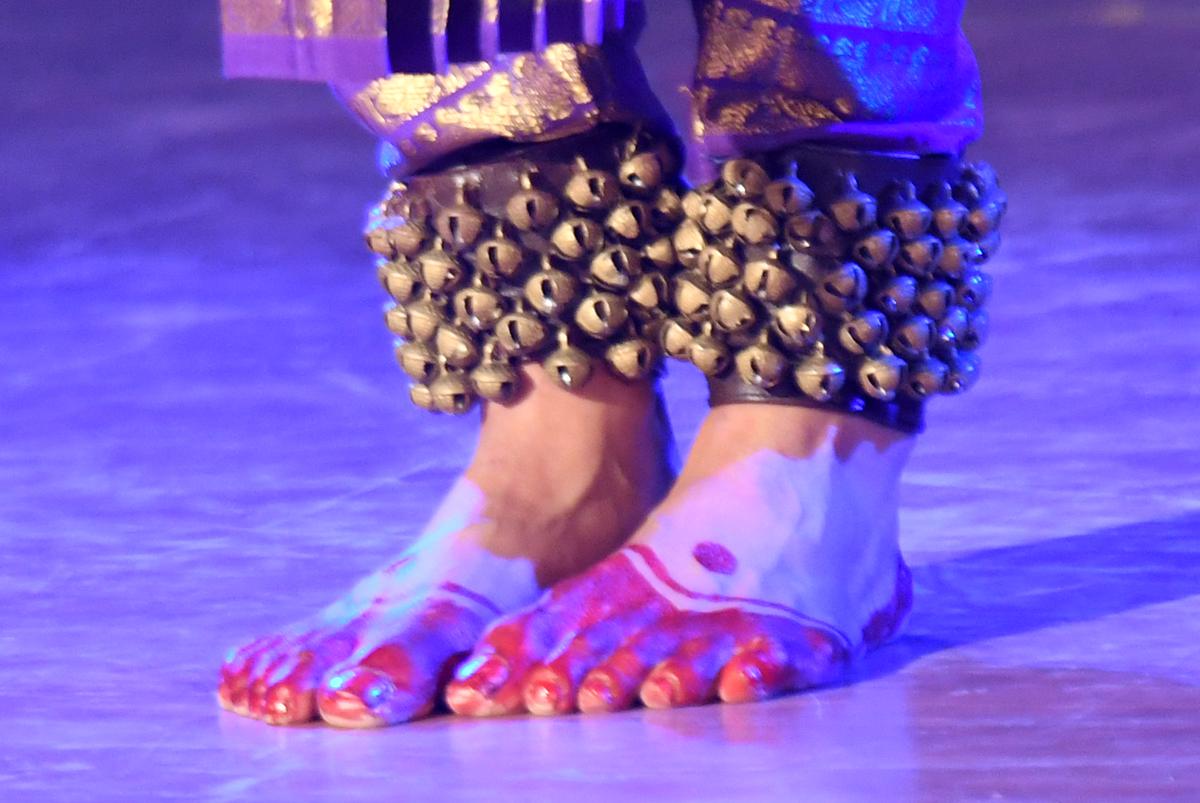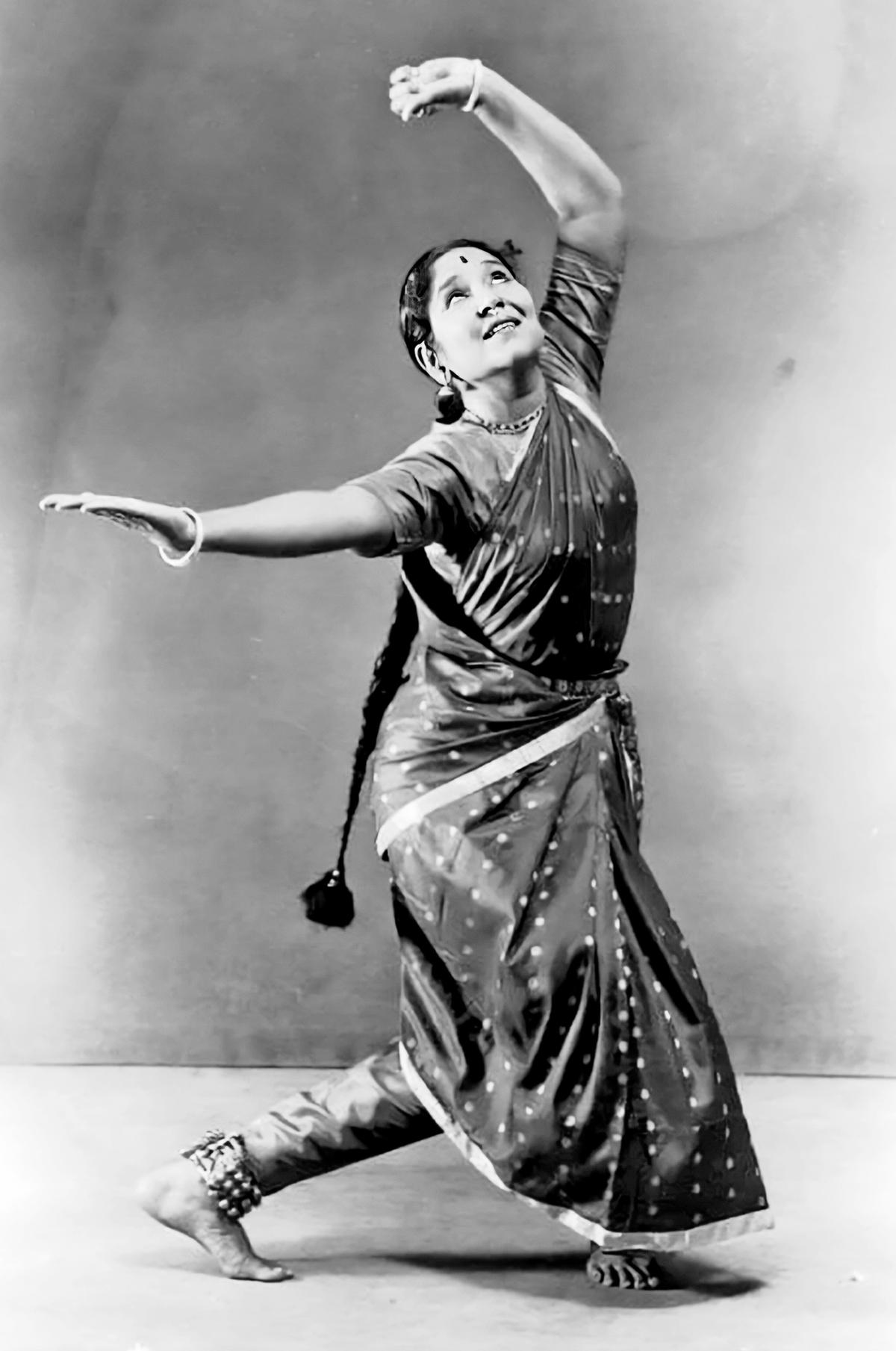
Ghungroo or salangai is an integral part of Indian classical dances
The clouds create a blanket of darkness as the rain pours. Covering her head, the abhisarika nayika traipses through the woods, lit only by occasional flashes of lightning. A snake attempts to wrap around her ankle, but she bravely shakes it off. Nothing can stop her from meeting her beloved. Her only companion — the anklets.
Ankle bells, also known as gejje, salangai, muvva, or gejjalu in South India and ghungroo up North, have captured the fancy of poet and king alike. The ornament, in its most delicate form as a golusu or payal, is indicative femininity and is a prescribed ornament for women in ancient texts such as Tiruvempavai of Manickavasagar.

The ankle bells add to the beauty of a dancer’s movements
| Photo Credit:
JOTHI RAMALINGAM B
While history may give it several prescriptive uses, how do we gain a practical sense of the anklet? Temple sculpture may contain the answers. The earliest documented anklets emerge from the repertoire of Buddhist terracottas and sculptures, with a representative example found on the famous Mauryan Didarganj Yakshi, dated to the 3rd century BC. This stunning sculpture, now at the Patna Museum, sports thick, tyre-like anklets that are more reminiscent of ankle weights at our local gym than of the delicate nupura described in the texts. In fact, foot ornaments as depicted in temple sculpture across India seem to contrast their delicate and artistic descriptions in the literature and scripture. In Belur, we are confronted with graceful and languorous darpanikas wearing several types of layered, chunky anklets. Even in photographs of courtesans from Tanjore and Mysore, we observe multiple, stacked anklets.
Some scholars are very particular about the distinction between ornaments. The manjira, it is argued, is clearly distinguished from the prakshepya by the former’s thinness. If one were to collate all of the words used in Sanskrit alone for the anklet, it is likely that the survey would yield more than 24 terms for different nuances of the ornament. If vernacular languages were to be considered, the count would sail well over a hundred. What was the function of so much variation within the concept of the anklet? Why was it important to distinguish between a salangai, a golusu and a silambu?
The sound of the ghungroos sets the pace of a Kathak performance
| Photo Credit:
FARUQUI AM
Perhaps the answer lies in the intended effect of the ankle ornament in the Indian imagination. Each of the varieties of anklets certainly had a different aesthetic value, but, more importantly, each had a different sonic value. In his book Nupura, S.P. Tewari suggests that it was the chiming of anklets that indicated female quarters in the palaces of yore. Epigraphs from the Edilpur Copperplate of Bengal clearly delineate the enjoyment of the “dulcet music arising from the anklets of courtesans every evening” by the 12th century Sena monarch, Lakshmanasena. It is well-documented that favoured courtesans would often receive anklets in precious metals, sometimes studded with gems, as imperial gifts.
The ethereal sound of the ghungroo wasn’t restricted to the court, however. Literature often uses the sound of the anklet as a character in itself. In Jayadeva’s 12th century magnum opus, the Gita Govinda, Radha says to her friend, “Take off these dangerous enemies, your ankle-bells. They talk loudly when you walk and enjoy union.” Saint-poet Meera refers to dancing in abandon (possessed by her affection for Krishna) with anklets on in the famous song ‘Pagh ghungroo baandh Meera nachi re’.

Balasaraswati’s ankle bells were kept in a glass case in an exhibition by the Museum of Performing Arts in New Delhi.
| Photo Credit:
The Hindu Archives
While these stories were told from the perspective of having an intimate relationship with the divine, the temple was a crucial site of the anklet’s history too. An essential aspect of the devadasi tradition was the gajjela puja or salangai puja, which marked the preparedness of a young dancer to takeover the ritual performances at the temple and consecrate her formal dedication to the patron god. While the context of this ritual was rooted in an ancient system that has little relevance to classical dance today, many believe that they are continuing the tradition of anklet puja by making it a mandatory element of a dancer’s debut (arangetram). Furthermore, the devadasi tradition documented the fashioning of anklets out of several different materials — namely gold, silver and bronze. Dancers of today rely on brass bells to serve a metronomic function on stage, but what could have been the hereditary dancing community’s reason for utilising anklets of different materials? How did it change?
In an exhibition by the Museum of Performing Arts, legendary dancer Balasaraswati’s ankle bells rested within a glass case. Tiny motifs were engraved on each brass bell, and the viewer could get a sense of the weight of the ornament just from looking at it. Balasaraswati was one of the last hereditary dancers to practice the form in its authentic context. She frequently discussed the need to tune her ankle bells. The sruti, she claimed, was an important aspect of the performance at large. She hailed from a tradition where the dancer provided vocal support for her own performances and thus we must ask whether the original purpose of the ankle bell was to serve as an instrument in its own right.
Perhaps the anklet is a study in itself — steeped in tradition yet completely customisable.
